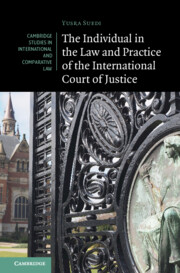Book contents
- The Individual in the Law and Practice of the International Court of Justice
- Cambridge Studies in International and Comparative Law: 192
- The Individual in the Law and Practice of the International Court of Justice
- Copyright page
- Contents
- Foreword
- Acknowledgements
- Table of Cases
- Introduction
- Part I The Individual in the Law of the International Court of Justice
- 1 Standing
- 2 Diplomatic Protection
- 3 Advisory Proceedings
- 4 Staff Members
- 5 Remarks on Law
- Part II The Individual in the Practice of the International Court of Justice
- Bibliography
- Index
- Cambridge Studies in International and Comparative Law
4 - Staff Members
from Part I - The Individual in the Law of the International Court of Justice
Published online by Cambridge University Press: 25 March 2025
- The Individual in the Law and Practice of the International Court of Justice
- Cambridge Studies in International and Comparative Law: 192
- The Individual in the Law and Practice of the International Court of Justice
- Copyright page
- Contents
- Foreword
- Acknowledgements
- Table of Cases
- Introduction
- Part I The Individual in the Law of the International Court of Justice
- 1 Standing
- 2 Diplomatic Protection
- 3 Advisory Proceedings
- 4 Staff Members
- 5 Remarks on Law
- Part II The Individual in the Practice of the International Court of Justice
- Bibliography
- Index
- Cambridge Studies in International and Comparative Law
Summary
This chapter addresses a former practice where international civil servants of certain UN organisations, who were not satisfied with the decisions rendered by the administrative tribunal dealing with their employment matters, were able to have these decisions re-examined by the Court. These proceedings drew much attention to the access and procedural inclusion of individuals before the World Court. It argues that the Court was indeed the incorrect forum for wronged UN staff members seeking redress due to its own Statute barring access to individuals and therefore entailing a permanent inequality of the parties. However, it argues that while the Court was handling such disputes, there were ways to adjust its procedural mechanisms to further bridge the inequality between the parties.
Keywords
- Type
- Chapter
- Information
- Publisher: Cambridge University PressPrint publication year: 2025

